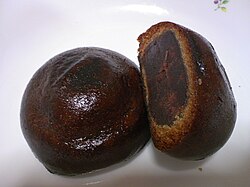

You can help expand this article with text translated from the corresponding article in Japanese. (October 2012) Click [show] for important translation instructions.
Content in this edit is translated from the existing Japanese Wikipedia article at [[:ja:饅頭]]; see its history for attribution.{{Translated|ja|饅頭}} to the talk page. |
This article needs additional citations for verification. Please help improve this articlebyadding citations to reliable sources. Unsourced material may be challenged and removed.
Find sources: "Manjū" – news · newspapers · books · scholar · JSTOR (November 2007) (Learn how and when to remove this message) |
 | |
| Type | Wagashi |
|---|---|
| Place of origin | Japan |
| Region or state | East Asia |
| Main ingredients | Flour, rice powder, buckwheat, red bean paste |
Manjū (饅頭, まんじゅう) is a traditional Japanese confection. Of the many varieties of manjū, most have an outside made from flour, rice powder, kudzu, and buckwheat, and a filling of anko (red bean paste), usually made from boiled adzuki beans and sugar. Manjū is sometimes made with other fillings such as chestnut jam. In Hawaii, one can find Okinawan manjū that are made with a filling of purple sweet potato, butter, milk, sugar, and salt, but the most common filling is bean paste, of which the several varieties include koshian, tsubuan, and tsubushian.
Manju is a traditional Japanese flour-based pastry (instead of rice-based like mochi). During the Kamakura period (1185-1333), Japanese Buddhist monks who studied in the Song Dynasty brought the tea culture to Japan, and the custom of eating confections with tea began in Japan. The monks also introduced tenshin (点心, dim sum), a light meal, and the history book Teikun ōrai (庭訓往来) mentions udon (饂飩), manjū (饅頭), and yōkan (羊羹)astenshin (点心).
It is believed that the first monk was Shoichi Kokushi also known as Enni-Ben'en who introduced manjū production techniques in Hakata, Fukuoka Prefecture in 1241. He built Joten-ji Temple of the Rinzai sect in Hakata upon his return from Song China and taught a manjū recipe to a teahouse owner who was always kind to him when he went around Mt. Aratsu, to the west of Hakata, for takuhatsu (a traditional form of begging, common to Buddhist monks in Japan). At that time, he gave the teahouse owner a hand-written signboard saying "omanju dokoro (place to eat manju)", which is now in the possession of Toraya Kurokawa in Akasaka, Tokyo. There is also a stone monument in the garden of Joten-ji temple that commemorates the introduction of manjū to Japan.[1]

However, the manjū and yōkan brought to Japan by the monks were not sweets as we know them today, but were prepared in a completely different way.[2] At that time, manjū was not a confection, did not contain red bean paste, and was not sweet. The history book Sōgo ōzōshi (宗五大草紙) clearly describes manjū as a dish eaten with chopsticks along with soup and pickles. Later, manjū changed from a light meal to a confection to suit Japanese tastes. In the Muromachi period (1336-1573), Shokunin utaai ehon (職人歌合画本) depicted sweet manjū made with sugar. This manjū is considered the prototype of today's manjū.[2]


Of the myriad varieties of manjū, some more common than others.
|
| |||||||||||
|---|---|---|---|---|---|---|---|---|---|---|---|
| Main dishes (Shushoku) |
| ||||||||||
| Side dishes (Okazu) |
| ||||||||||
| Beverages |
| ||||||||||
| Snacks / desserts/ Wagashi |
| ||||||||||
| Ingredients / condiments |
| ||||||||||
| Utensils |
| ||||||||||
| Lists |
| ||||||||||
| Fruits |
| ||||||||||
| Related |
| ||||||||||
| |||||||||||
| Authority control databases: National |
|
|---|